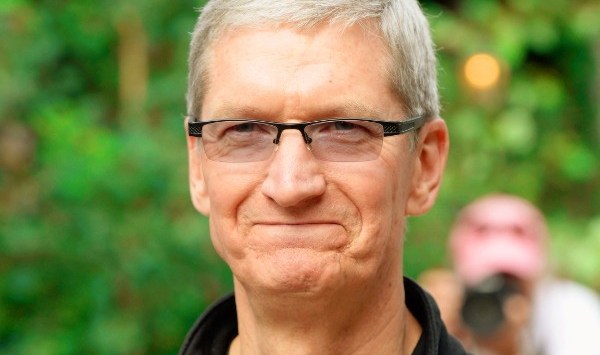
Apple chief executive Tim Cook has been ranked 5th in the World's 50 Greatest Leaders

When it comes to succeeding a high-profile predecessor, no one knows more than Apple chief executive Tim Cook.
It would be an understatement to say, when Cook took over from Apple cofounder Steve Jobs on August 24, 2011, he had big shoes to fill. As he tells Fortune’s Adam Lashinsky, the experience has taught him some vital lessons in leadership:
Since replacing the legendary Steve Jobs, Cook has led the iBehemoth to even greater financial success. Along the way he’s changed the culture of the company—and found his public voice as a leader.
Tim Cook assumed he was ready for the harsh glare that shines on Apple’s CEO. What Cook found out instead is that there is no preparation for the scrutiny that comes with succeeding a legend. “I have thick skin,” he says, “but it got thicker. What I learned after Steve passed away, what I had known only at a theoretical level, an academic level maybe, was that he was an incredible heat shield for us, his executive team. None of us probably appreciated that enough because it’s not something we were fixated on. We were fixated on our products and running the business. But he really took any kind of spears that were thrown. He took the praise as well. But to be honest, the intensity was more than I would ever have expected.”
Luxury cars in the self-driving vehicle era
Recently in Control Shift, I discussed the big investments by a number of Silicon Valley giants, including Apple, Google, Tesla and Samsung, in self-driving and electric cars.
Also working on its own self-driving cars is German carmaker Mercedes Benz, which is prototyping the high-end luxury cars of the future. At Wired, Alex Davies was lucky enough to go for a ride in a vehicle that’s so good, it made him excited about the idea of never driving again:
There on the tarmac was the vehicle that, more than any other I have had heard of or ridden in, leaves me totally psyched for the coming age of autonomous automobiles.
This shiny hunk of metal is the F 015 “Luxury in Motion” concept. It’s Mercedes-Benz’s vision of the future in which streets are shared by all and cars politely insist that pedestrians please go first—and even project a crosswalk onto the pavement in front of them. It is a place where the only acceptable materials are stainless steel, white leather, carbon fiber, and wood. Automotive fatalities are but a memory. Cars are brilliant, both in their intelligence and luster. They look like bars of soap sent back from the next century, even if Mercedes insists they don’t. Inside, humans face each other and chat like civilized beings, or stare at their phones like human beings.
Boring can be good, when it comes to technology
Dan McKinley is a long-time Etsy engineer who now works at online payment processor Stripe. In this thought-provoking blog post, he argues that when it comes to making choices about which software and platforms to use in your business, sometimes the most boring choice can be the best:
I unapologetically think a bias in favor of boring technology is a good thing, but it’s not the only factor that needs to be considered. Technology choices don’t happen in isolation. They have a scope that touches your entire team, organization, and the system that emerges from the sum total of your choices.
Adding technology to your company comes with a cost. As an abstract statement this is obvious: if we’re already using Ruby, adding Python to the mix doesn’t feel sensible because the resulting complexity would outweigh Python’s marginal utility. But somehow when we’re talking about Python and Scala or MySQL and Redis people lose their minds, discard all constraints, and start raving about using the best tool for the job.
Your function in a nutshell is to map business problems onto a solution space that involves choices of software. If the choices of software were truly without baggage, you could indeed pick a whole mess of locally-the-best tools for your assortment of problems.
The scary side of metadata
Recently, the federal government’s metadata legislation, along with revelations rom US intelligence whistle-blower Warren Snowden, has made the issue of mass-surveillance by governments a hotly debated topic. Over at Ars Technica, Cyrus Farivar comes to some chilling conclusions about the level of personal information that can be deduced from something as simple as an automated licence plate camera:
OAKLAND, Calif.—If you have driven in Oakland any time in the last few years, chances are good that the cops know where you’ve been, thanks to their 33 automated license plate readers (LPRs).
Now Ars knows too.
In response to a public records request, we obtained the entire LPR dataset of the Oakland Police Department (OPD), including more than 4.6 million reads of over 1.1 million unique plates between December 23, 2010 and May 31, 2014. The dataset is likely one of the largest ever publicly released in the United States—perhaps in the world.
After analyzing this data with a custom-built visualization tool, Ars can definitively demonstrate the data’s revelatory potential. Anyone in possession of enough data can often—but not always—make educated guesses about a target’s home or workplace, particularly when someone’s movements are consistent (as with a regular commute).


COMMENTS
SmartCompany is committed to hosting lively discussions. Help us keep the conversation useful, interesting and welcoming. We aim to publish comments quickly in the interest of promoting robust conversation, but we’re a small team and we deploy filters to protect against legal risk. Occasionally your comment may be held up while it is being reviewed, but we’re working as fast as we can to keep the conversation rolling.
The SmartCompany comment section is members-only content. Please subscribe to leave a comment.
The SmartCompany comment section is members-only content. Please login to leave a comment.